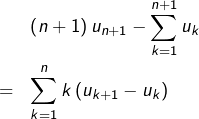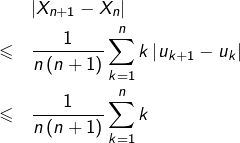Solution pour le challenge 17
Il est crucial de faire apparaître les écarts ![]() , car ils sont tous majorés par 1 et c’est la seule hypothèse que nous ayons.
, car ils sont tous majorés par 1 et c’est la seule hypothèse que nous ayons.
Pour cela, on effectue une transformation d’Abel, c’est-à-dire en quelque sorte une « intégration par parties discrète » :
![Rendered by QuickLaTeX.com \begin{eqnarray*}& &\sum_{k=1}^{n+1}u_{k}\\& = & \sum_{k=1}^{n+1}\left[k-\left(k-1\right)\right]u_{k}\\& = & \sum_{k=1}^{n+1}ku_{k}-\sum_{k=0}^{n}ku_{k+1}\end{eqnarray*}](https://math-os.com/wp-content/ql-cache/quicklatex.com-a7a8fc3186cf0263c2d406cc3fd4aa3d_l3.png)

On divise alors chaque membre par
![Rendered by QuickLaTeX.com \[\frac{u_{n+1}}{n}-\left(\frac{1}{n}-\frac{1}{n+1}\right)\sum_{k=1}^{n+1}u_{k}\]](https://math-os.com/wp-content/ql-cache/quicklatex.com-261486d6a6c1ce56fd11940e6317ecf0_l3.png)
![Rendered by QuickLaTeX.com \[=\frac{1}{n\left(n+1\right)}\sum_{k=1}^{n}k\left(u_{k+1}-u_{k}\right)\]](https://math-os.com/wp-content/ql-cache/quicklatex.com-4603dc4a2891aaecfad96aa9764f97f0_l3.png)
c’est-à-dire :

On applique maintenant l’inégalité triangulaire :

et comme
 on conclut que :
on conclut que :
![Rendered by QuickLaTeX.com \[\boxed{\left|X_{n+1}-X_{n}\right|\leqslant\frac{1}{2}}\]](https://math-os.com/wp-content/ql-cache/quicklatex.com-72773d0fa993aced7979f72467fd4491_l3.png)
En outre, cette majoration est optimale puisque si ![]() pour tout
pour tout ![]() alors l’hypothèse est bien vérifiée et, pour tout
alors l’hypothèse est bien vérifiée et, pour tout ![]() :
:
![Rendered by QuickLaTeX.com \[X_{n}=\frac{1}{n}\sum_{k=1}^{n}k=\frac{n+1}{2}\]](https://math-os.com/wp-content/ql-cache/quicklatex.com-976895fc2924d73adaa6a0d144450a52_l3.png)
Pour consulter l’énoncé, c’est ici

